Interior and exterior angles of a polygon
Categories: gcse geometry
Level:

Here are some basic geometry rules about the interior and exterior angles of a polygon. They are also covered in this video:
Interior angles of a polygon
The angles inside a polygon are called its interior angles. Here is a 5-sided, irregular polygon, showing its interior angles:
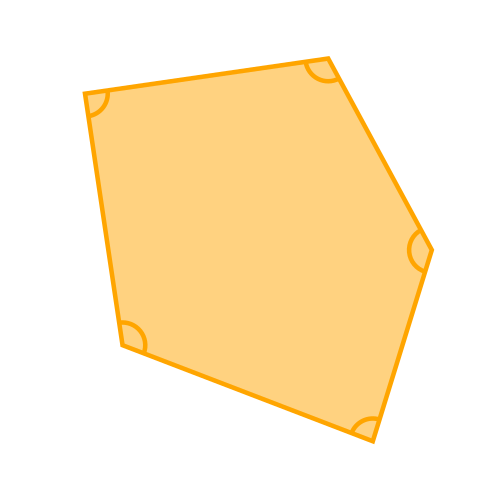
Exterior angles of a polygon
If we extend one of the sides of a polygon, the angle between the extended side and the side next to it is called an exterior angle. We can do this for each side of the shape:
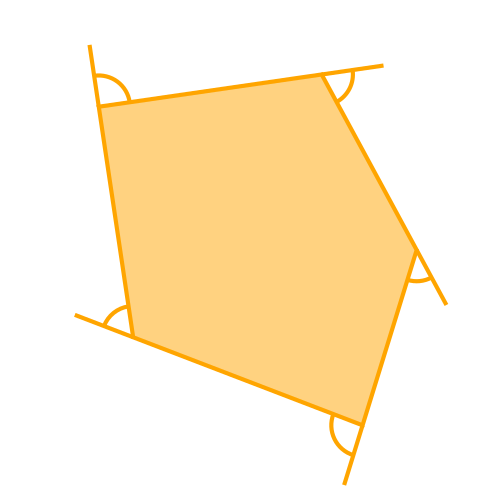
The sum of the exterior angles
The sum of the exterior angles in a polygon is always 360°. It doesn't matter how many sides the shape has, the sum of the exterior angles is always the same.
To see why this is the case, imagine an ant crawling round the outside of the shape. Assume it goes in a clockwise direction. Each time it reaches a corner, the ant will turn to its right. It will turn through the exterior angle of that corner, so it faces in the correct direction to walk along the next side.
By the time the ant gets all the way around the shape it will have turned at each corner, so the total angle it has turned through will be the sum of the exterior angles of the shape. But after the ant has gone all the way around the shape it will be facing the same way as it was when it started, which means it has turned through 360°. Therefore the sum of the exterior angles in a polygon is 360°.
Here is another way to visualise this. Let's take the previous diagram and make the polygon smaller:
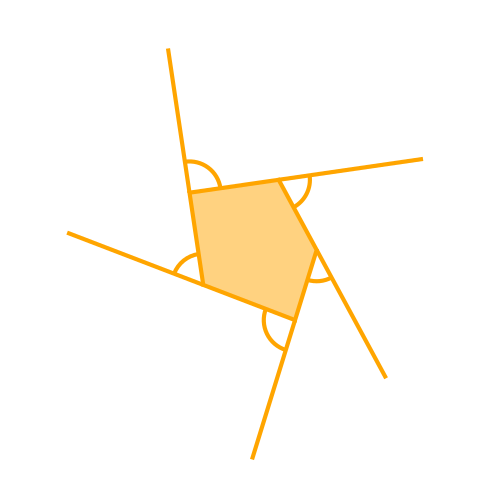
Although the shape is smaller, it is still the same shape, so the exterior angles are still the same. Now let's make the shape very small, so you can hardly see it:
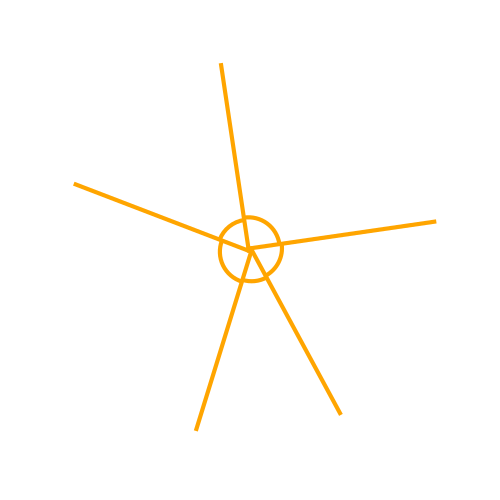
Again, this illustrates that the sum of the exterior angles of a polygon is 360°.
For a regular polygon, each exterior angle is the same, so each angle of an n-sided polygon is 360°/n.
The diagram shows the sum of the exterior angle of a 5-sided polygon, or pentagon, which is 360° (the same as any polygon).
Each exterior angle of a regular pentagon is 360°/5, or 72°.
The sum of the interior angles
The sum of the interior angles is not quite so straightforward, but it is still quite a simple formula. It depends on the number of sides, n:
sum of interior angles = (n - 2) x 180
We can see how this is the case by dividing our shape into triangles, like this:
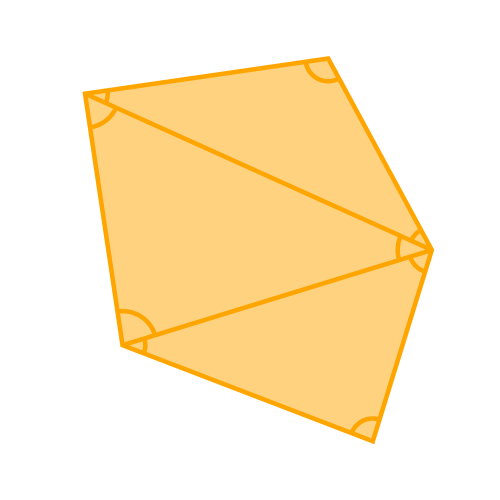
In this case, the original polygon has 5 sides, so we can divide it into 3 triangles. Every angle of every triangle contributes to one of the interior angles, and we know the rules of geometry that the interior angles of a triangle add up to 180°. So the sum of the interior angles of a 5-sided shape is 3 x 180 (which fits in with the formula above).
So we know that:
- The interior angles of a triangle are 1 x 180 (from the rules of geometry).
- The interior angles of a quadrilateral are 2 x 180 (from the rules of geometry).
- The interior angles of a 5-sided polygon are 3 x 180 (shown above).
It is quite easy to show that a 6-sided shape can be split into 4 triangles, a 7-sided shape into 5 triangles, and so on, so the formula above applies to all polygons.
For a regular polygon, each exterior angle is the same, so each interior angle of an n-sided polygon is:
sum of interior angles = (n - 2) x 180/n
The diagram shows the sum of the interior angle of a 5-sided polygon, or pentagon, which is 3 times 180°, or 540°
Each interior angle of a regular pentagon is 3 times 180° divided by 5, or 108°.
Alternative proof
There is another way to look at interior and exterior angles that, of course, gives the same result in a different way.
Here is the same polygon with all the interior and exterior angles drawn:
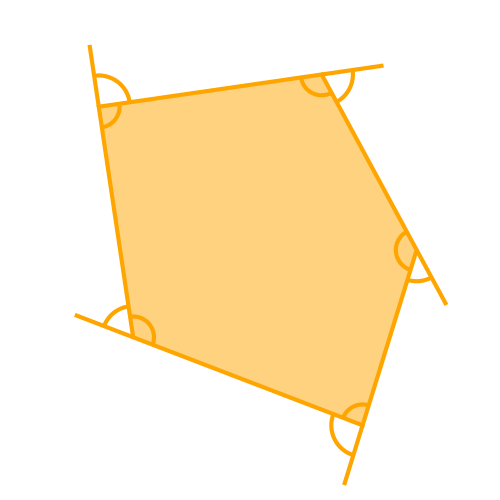
The important thing here is the interior and exterior angles at each corner form a straight line. In other words, they add up to 180°.
This means that for an n-sided shape, the total of all the interior and exterior angles is:
n x 180°
And since we know that the total of the exterior angles is 360°, this means that the total of the interior angles is:
(n x 180°) - 360°
or:
(n - 2) x 180°
which is the formula given above.
Related articles
- Regular polygons
- Triangles
- Quadrilaterals
- Quadrilateral family tree
- Pentagons - polygons with 5 sides
- Hexagons - polygons with 6 sides
- Heptagons - polygons with 7 sides
- Octagons - polygons with 8 sides
- Nonagons - polygons with 9 sides
- Decagons - polygons with 10 sides
- Hendecagons - polygons with 11 sides
- Dodecagons - polygons with 12 sides
- n-gons - polygons with any number of sides
- Other types of polygon
- Star polygons

Popular tags
adder adjacency matrix alu and gate angle answers area argand diagram binary maths cardioid cartesian equation chain rule chord circle cofactor combinations complex modulus complex numbers complex polygon complex power complex root cosh cosine cosine rule countable cpu cube decagon demorgans law derivative determinant diagonal directrix dodecagon e eigenvalue eigenvector ellipse equilateral triangle erf function euclid euler eulers formula eulers identity exercises exponent exponential exterior angle first principles flip-flop focus gabriels horn galileo gamma function gaussian distribution gradient graph hendecagon heptagon heron hexagon hilbert horizontal hyperbola hyperbolic function hyperbolic functions infinity integration integration by parts integration by substitution interior angle inverse function inverse hyperbolic function inverse matrix irrational irrational number irregular polygon isomorphic graph isosceles trapezium isosceles triangle kite koch curve l system lhopitals rule limit line integral locus logarithm maclaurin series major axis matrix matrix algebra mean minor axis n choose r nand gate net newton raphson method nonagon nor gate normal normal distribution not gate octagon or gate parabola parallelogram parametric equation pentagon perimeter permutation matrix permutations pi pi function polar coordinates polynomial power probability probability distribution product rule proof pythagoras proof quadrilateral questions quotient rule radians radius rectangle regular polygon rhombus root sech segment set set-reset flip-flop simpsons rule sine sine rule sinh slope sloping lines solving equations solving triangles square square root squeeze theorem standard curves standard deviation star polygon statistics straight line graphs surface of revolution symmetry tangent tanh transformation transformations translation trapezium triangle turtle graphics uncountable variance vertical volume volume of revolution xnor gate xor gate